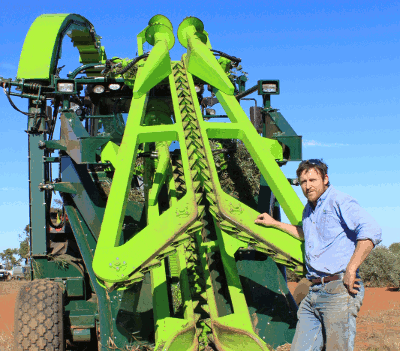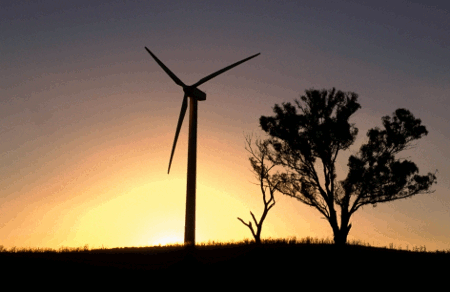
|
Published: 26 September 2011
WA mallee farmers take myrtle rust threat seriously
A harvester designed in Western Australia to cut and chip mallee crops will be kept in ‘quarantine’ on the eastern seabord to prevent the spread of myrtle rust spores that may have attached onto the machine during trials there.

|
|
Richard Sulman from Biosystems Engineering with the mallee harvester he invented. Credit:
FFI CRC
|
Peter Zurzolo, Deputy CEO of Future Farm Industries CRC – a partner in the harvester’s development – said that until the risks and possible control methods were evaluated it would be unwise to bring the harvester back to WA.
‘We took a tough decision,’ Mr Zurzolo said. ‘The mallee harvester has been used in trials on the eastern seaboard near areas that are affected by myrtle rust. Based on expert advice we could not guarantee that the harvester is not contaminated with myrtle rust spores.’
Myrtle rust is a fungal pathogen that affects plants belonging to the Myrtaceae family, which includes eucalypts, myrtles and bottlebrushes. The rust is native to South America and is also found in parts of the United States of America and Central America.
In Australia, it was first detected on the central coast of New South Wales in late April 2011. It has spread to numerous near-coastal locations in New South Wales and Queensland.
‘There is no evidence that myrtle rust is in Western Australia and bringing myrtaceous plants into WA from other states has been prohibited. If it gets in here, it could be devastating. This pathogen affects and may kill some Australian plants, including eucalypts. It has the potential to affect the natural environment and some industries,’ Mr Zurzolo said.
‘We know that mallee growers in WA are keen to see the new prototype harvester in action and we had planned to give them that opportunity later this month. Unfortunately that will not happen for the time being.’
Lex Hardie, President of the Oil Mallee Association, said he supported the decision not to bring the harvester to WA at this stage.
‘Of course it is disappointing that mallee growers here won’t get to see the harvester in action in the near future. But if it did come back and brought myrtle rust with it, serious damage to some plant industries and the environment is likely, and none of us want that. Future Farm CRC’s decision is sensible.’
The harvester cuts costs by harvesting the mallee trees and chipping them on site prior to the biomass being converted into energy. Mr Zurzolo said that research on the harvester was continuing and Biosystems Engineering, the machine’s developer, was on track to proving its effectiveness and reliability.
‘The original plan was to run the final trials of the harvester in WA but they will now be conducted in eastern Australia.
‘Our determination to see a mallee industry up and running, with a secure supply chain, including an efficient and economic harvester, has not lapsed in any way. Our work with our partners in the biofuel industry is proceeding apace. Myrtle rust has only changed the location at which some of our trials will be conducted. Everything else is proceeding well.’
ECOS recently covered the myrtle rust threat in Australia – our comprehensive perspective can be found here
Source: Future Farm Industries CRC



